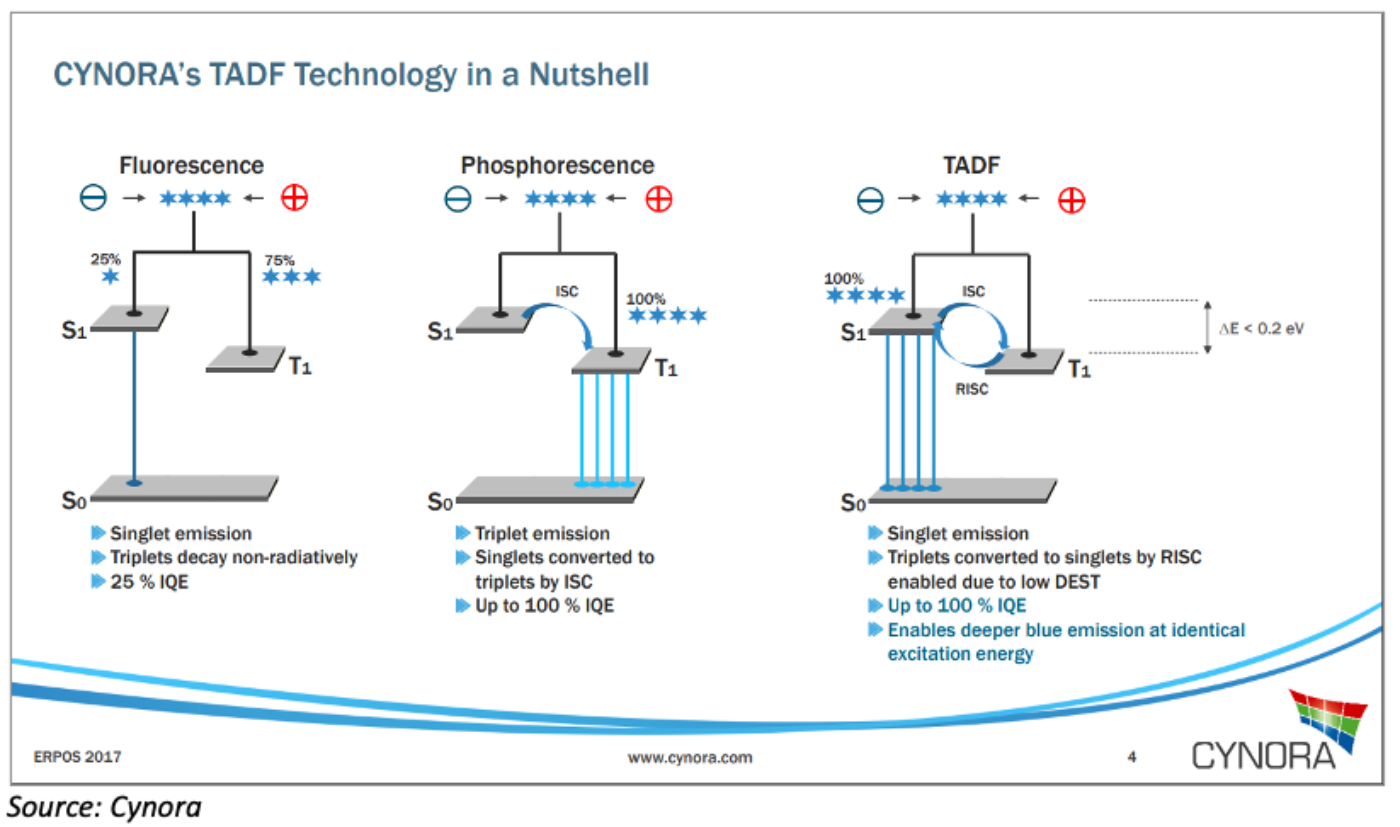Samsung Display、OLED部材の新興企業Cynoraを買収
冒頭部和訳
Samsung Display Co. (SDC) が、OLED部材を手掛けるドイツ企業、Cynoraを買収したことが、Bloombergの報道やその他業界筋の情報から明らかになった。買収額は非公開である。SDCはCynoraが保有する知的財産権を取得したが、人員は獲得していない。Cynoraではここ数週間で人員整理が行われたことをBloombergが伝えており、業界筋もこれを認めている。
Bloombergは買収額を3億ドルと報じているが、複数の情報源がこの金額に異議を唱えており、DSCCは実際の金額は大幅に低いと考えている。Cynoraによる提示価格が3億ユーロだった、または換算時の誤りによる10倍の誤差がある可能性を、複数の情報筋が示唆している。韓国のウェブサイトTheElecは1億ドルと推定しているが、DSCCの情報源の見方はそれより少なく、数千万ドル規模を示唆している。
Samsung Display Acquires OLED Material Start-up Cynora
Samsung Display Co. (SDC) has acquired the German OLED material company Cynora for an undisclosed sum, according to a report from Bloomberg and from various industry sources. SDC has acquired the intellectual property rights held by Cynora but not the workforce. Cynora’s workforce has been terminated in recent weeks, according to Bloomberg and confirmed by industry sources.
The Bloomberg article listed the price of the acquisition as $300 million, but various sources dispute that amount and DSCC believes that the actual amount was far less. Various sources have suggested that 300 million euros was the asking price by Cynora or that the figure was a translation error off by a factor of 10. The Korean site TheElecsuggested a price of $100 million, but our sources suggest a smaller sum ranging from low to high tens of millions of dollars.
The acquisition could be a death blow to what once seemed a promising venture to revolutionize the market for OLED materials. Cynora had attempted to develop efficient OLED emitters using Thermally Activated Delayed Fluorescence (TADF) technology, an alternative to the phosphorescent emitters sold by Universal Display Corporation (UDC) that dominate the market for red and green emitters. Several other start-up companies have been pursuing similar technology for improving OLED emission, including Japan-based Kyulux, Poland-based Noctiluca and China-based Summer Sprout, all targeting the keystone materials for the rapidly growing OLED display market.
Cynora had originally targeted to make a TADF blue emitter. The current technology used for blue emitters is fluorescence, which is limited to only 25% internal quantum efficiency. Phosphorescent and TADF emitters can theoretically achieve 100% internal quantum efficiency, and although in real-life application the external quantum efficiency (EQE) realized is much lower (typically in the 20s%), both phosphorescent and TADF emitters provide a dramatic improvement over fluorescence. An efficient blue has been the “Holy Grail” of OLED material research, and earlier this year UDC announced that it expected to commercialize a phosphorescent blue emitter by 2024.
At SID Display Week 2017, Cynora’s then-CEO Gildas Sorin claimed that the company was on track to introduce a commercially available TADF blue material by the end of 2017. Cynora expected to be able to reach its customers’ target performance of 15% EQE, a CIEy color coordinate <0.1, and 100 hours lifetime (LT97). In July of that year, Cynora announced that it had reached a new milestone for TADF blue performance and had met the EQE and color point targets and therefore only needed to improve lifetime.
The progress on blue stimulated interest from OLED panel makers, and Cynora announced in August 2017 that it had received investments from both Samsung Display and LG Display totaling €25 million. In a preview of the current uncertainty over the Cynora sale price, the initial estimates of the 2017 investment suggested a total of €250 million, which was later corrected.
In early 2018, after missing its target, Cynora stressed that it continued to make progress and expected to commercialize later that year. In the fall of 2018 Cynora announced an extended Joint Development Agreement with LG Display, and at that point revealed that it was working on two parallel approaches to get a blue emitter: a single TADF material, or a second approach using TADF as a co-emitter with a fluorescent emitter. The latter approach is the same method used by Japanese startup Kyulux, which they refer to as hyperfluorescence.
By 2019 Cynora had not achieved its goal but continued to report progress on blue and continued to report that it had achieved commercial targets for efficiency and color but not lifetime. In May 2019 Cynora announced that it had secured $25 million in Series C funding from investors in Asia, Europe and the US and announced a new CEO, Adam Kablanian.
Kablanian redirected Cynora from its prior research emphasis toward commercializing its material technology. In March 2020 Cynora announced its first commercial product, a fluorescent blue emitter that it claimed was 15% more efficient than existing products. Later that year Cynora said that its research focus had shifted to green emitters. In early 2021 Cynora announced a new material which it called cyUltimateGreen, which had high efficiency and a better color point than the existing phosphorescent green from UDC. At that point, Cynora said that they expected to see commercial sales in 2022.
Although Cynora claimed that its customers responded enthusiastically to its blue and green emitter products, DSCC understands that these products have never been introduced in mass production at any OLED panel maker. Therefore, it is unclear whether Cynora had any appreciable revenue, and likely was surviving only via cash infusions from investors. Our sources suggest that Cynora sought to be acquired in early 2021 at a price of €300 million, but the valuation has been severely diminished since then.
What are SDC’s plans for Cynora? Since they acquired only the intellectual property and the research staff has been let go, SDC presumably does not plan further R&D of TADF materials. The most likely prospect is that SDC will use the Cynora IP to negotiate a more favorable deal with UDC for royalties on phosphorescent emitters including blue. SDC has an existing 5-year royalty deal with UDC that expires at the end of 2022, so negotiations between the two companies may have already started.
SDC may also try to introduce the TADF green emitter through a contract manufacturer. Cynora did not plan to manufacture its emitter materials itself but rather expected to engage a contract manufacturer. Similarly, UDC employs PPG as a contract manufacturer for its phosphorescent materials. Even if it does not introduce a TADF green, SDC can use the threat to do so as negotiating leverage against UDC.
Investors appear to consider the Cynora acquisition by SDC to be bad news for UDC. UDC’s stock dropped by 7.6% on Wednesday morning after the news appeared while the broader NASDAQ index was off a fraction of a percent. In common with other stocks whose valuation is based on growth prospects, UDC’s stock is down sharply since the beginning of the year; down 40% since January 1st.

